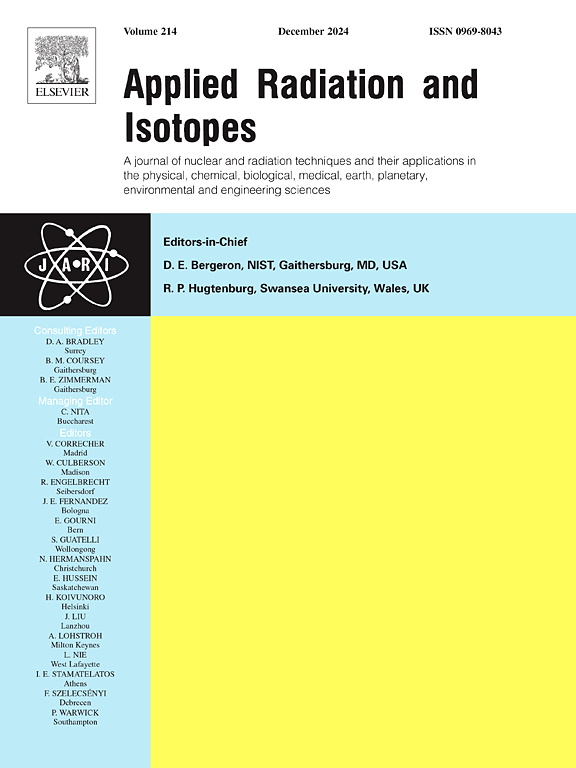芹菜素、阿卡乙素和根黄素对放射免疫测定三碘甲状腺原氨酸激素的影响
IF 1.6
3区 工程技术
Q3 CHEMISTRY, INORGANIC & NUCLEAR
引用次数: 0
摘要
放射免疫测定法(RIA)是用于鉴定甲状腺疾病的实验室检测技术之一。芹菜素及其衍生物是近年来发现的一种有效的抗肿瘤天然物质。本研究主要研究了芹菜素、阿曲素和根黄素对三碘甲状腺原氨酸(T3)测定的影响。本研究使用商用T3 RIA试剂盒。方法按生产厂家说明书进行测定。简单地说,将50、100和200 μM的芹菜素、金曲素和根万素与125i标记的T3示踪剂混合,在室温下涂有抗T3抗体的管中混合2小时。这些患者分别用125i标记的T3示踪剂单独处理。使用伽马井计数器评估束缚形式的每分钟伽马辐射。计数值用于计算绑定示踪剂的百分比。0 μM的apigenin、acacetin和genkwanin作为对照。结果与对照组(0 μM)相比,50、100和200 μM的芹菜素、金曲素和根黄素组T3的结合率明显降低。这些发现表明,当放射免疫法用于测定血液或组织样本中的T3时,芹菜素、金曲素和根黄素可能会引起问题。本文章由计算机程序翻译,如有差异,请以英文原文为准。
Effect of apigenin, acacetin, and genkwanin on triiodothyronine hormone measurement using radioimmunoassay
Background
Radioimmunoassay (RIA) is one of the techniques used laboratory tests for identifying thyroid disease. Apigenin and its derivatives were recently introduced as an effective anti-neoplastic natural substance. This current study focused on the effect of apigenin, acacetin, and genkwanin on triiodothyronine (T3) assays using RIA. A commercial T3 RIA kit was used in this study.
Methods
The assay was performed according to the manufacturer's instructions. Briefly, 50, 100, and 200 μM of apigenin, acacetin, and genkwanin were mixed with 125I-labelled T3 tracers in tubes coated with anti-T3 antibodies for 2 h at room temperature. These were individually treated independently with 125I-labelled T3 tracers. The bound forms were assessed for gamma emission per minute using a gamma well counter. The count values were used to calculate the percentage of bound tracer. The 0 μM of apigenin, acacetin, and genkwanin served as controls.
Results
The results indicated that the percentage of T3 bound at concentrations of 50, 100, and 200 μM of apigenin, acacetin, and genkwanin decreased compared to the control group (0 μM).
Conclusion
These findings suggest that apigenin, acacetin, and genkwanin may cause issues when radioimmunoassay is used to determine T3 in blood or tissue samples.
求助全文
通过发布文献求助,成功后即可免费获取论文全文。
去求助
来源期刊

Applied Radiation and Isotopes
工程技术-核科学技术
CiteScore
3.00
自引率
12.50%
发文量
406
审稿时长
13.5 months
期刊介绍:
Applied Radiation and Isotopes provides a high quality medium for the publication of substantial, original and scientific and technological papers on the development and peaceful application of nuclear, radiation and radionuclide techniques in chemistry, physics, biochemistry, biology, medicine, security, engineering and in the earth, planetary and environmental sciences, all including dosimetry. Nuclear techniques are defined in the broadest sense and both experimental and theoretical papers are welcome. They include the development and use of α- and β-particles, X-rays and γ-rays, neutrons and other nuclear particles and radiations from all sources, including radionuclides, synchrotron sources, cyclotrons and reactors and from the natural environment.
The journal aims to publish papers with significance to an international audience, containing substantial novelty and scientific impact. The Editors reserve the rights to reject, with or without external review, papers that do not meet these criteria.
Papers dealing with radiation processing, i.e., where radiation is used to bring about a biological, chemical or physical change in a material, should be directed to our sister journal Radiation Physics and Chemistry.
 求助内容:
求助内容: 应助结果提醒方式:
应助结果提醒方式:


